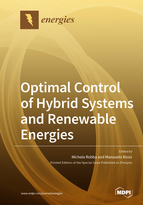Optimal Control of Hybrid Systems and Renewable Energies
A special issue of Energies (ISSN 1996-1073). This special issue belongs to the section "F: Electrical Engineering".
Deadline for manuscript submissions: closed (31 January 2020) | Viewed by 36908
Special Issue Editors
Interests: optimization; control; planning and control of smart grids; electric vehicles
Special Issues, Collections and Topics in MDPI journals
Special Issue Information
Dear Colleagues,
International policies for sustainable development have led to an increase of distributed power production based on renewable resources. However, on the one hand, their intermittency may create problems for the electrical grid, and, on the other hand, they are costly. It is necessary to define new technological solutions that can reduce costs and new control strategies to optimally manage renewable resources and to integrate them into the new energy systems, which are more and more characterized by the close interaction between different energy vectors and their networks (thermal, electrical, etc.) and by a transition from a centralized structure to a decentralized one (both in terms of sources and controls).
The main aim of this Special Issue is to collect papers in the field of the optimal control of power and energy production from renewable resources (wind, PV, biomass, hydrogen, etc.). The specific topics of the Special Issue (but not limited to) are:
- Modelling and control of wind turbines, PV and solar thermal plants, etc.;
- Optimal control of hybrid systems (wind, hydrogen, fuel cells, hydro-electric plants, etc.);
- Operational management of biomass-based power plants;
- Optimization and control of energy systems;
- Stochastic optimization;
- Model predictive control;
- Distributed optimization;
- Optimal control of storage systems;
- Modelling and control of flexible loads.
Prof. Dr. Michela Robba
Prof. Dr. Mansueto Rossi
Guest Editors
Manuscript Submission Information
Manuscripts should be submitted online at www.mdpi.com by registering and logging in to this website. Once you are registered, click here to go to the submission form. Manuscripts can be submitted until the deadline. All submissions that pass pre-check are peer-reviewed. Accepted papers will be published continuously in the journal (as soon as accepted) and will be listed together on the special issue website. Research articles, review articles as well as short communications are invited. For planned papers, a title and short abstract (about 100 words) can be sent to the Editorial Office for announcement on this website.
Submitted manuscripts should not have been published previously, nor be under consideration for publication elsewhere (except conference proceedings papers). All manuscripts are thoroughly refereed through a single-blind peer-review process. A guide for authors and other relevant information for submission of manuscripts is available on the Instructions for Authors page. Energies is an international peer-reviewed open access semimonthly journal published by MDPI.
Please visit the Instructions for Authors page before submitting a manuscript. The Article Processing Charge (APC) for publication in this open access journal is 2600 CHF (Swiss Francs). Submitted papers should be well formatted and use good English. Authors may use MDPI's English editing service prior to publication or during author revisions.
Keywords
- optimal control
- optimization
- renewable resources
- storage systems
- power converters
- wind
- biomass
- photovoltaics
- solar thermal







